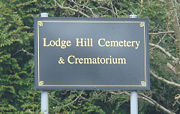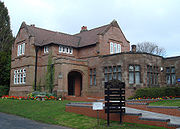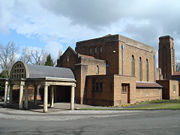
Lodge Hill Cemetery, Birmingham
Encyclopedia

Selly Oak
Selly Oak is a residential suburban district in south-west Birmingham, England. The suburb is bordered by Bournbrook and Selly Park to the north-east, Edgbaston and Harborne to the north, Weoley Castle and Weoley Hill to the west, and Bournville to the south...
, Birmingham
Birmingham
Birmingham is a city and metropolitan borough in the West Midlands of England. It is the most populous British city outside the capital London, with a population of 1,036,900 , and lies at the heart of the West Midlands conurbation, the second most populous urban area in the United Kingdom with a...
, England
England
England is a country that is part of the United Kingdom. It shares land borders with Scotland to the north and Wales to the west; the Irish Sea is to the north west, the Celtic Sea to the south west, with the North Sea to the east and the English Channel to the south separating it from continental...
. The cemetery was first opened by King’s Norton Rural District Council in 1895, and during the 1930s became the site of Birmingham's first crematorium.
Having its main entrance in Weoley Park Road, the cemetery is bounded by Weoley Avenue, Kemberton Road and Castle Road. It can be reached by buses X64 and 448 from Birmingham, Weoley Castle and Longbridge, and numbers 29 and 29A run close by. Nearby is the Weoley Castle
Weoley Castle
-External links:****** - Educational teaching sessions and resources at Weoley Castle* - fun and games for children based on Weoley Castle...
ruin of a moated and fortified mediaeval manor house. Further down the hill the disused Selly Oak to Lapal Canal path runs at a tangent to the site. At the bottom of the hill runs the Bourn Brook
Bourn Brook
Bourn Brook is a common name for small rivers, reflected in a number of place names. See:* Bourn Brook, Cambridgeshire* Bournbrook, Birmingham* Bournville, Birmingham...
.

History

John James Stewart Perowne
John James Stewart Perowne was an English bishop. Born in Burdwan, Bengal, Perowne was a member of a notable clerical family, whose origins were Hugenot....
.
The cemetery passed to the care of Birmingham Corporation in 1911 with the absorption of King’s Norton and Northfield Urban District Council following the Greater Birmingham Act. It was extended in 1925 to cover just of 61 acres (246,858.5 m²), and in 1934 saw the building of Birmingham’s first municipal crematorium. The crematorium and chapel, which first opened for use in 1937, cost £9,000 and was designed by the Arts & Crafts architect Holland W. Hobbiss
Holland W. Hobbiss
Holland W. Hobbiss was an architect in the Birmingham area of England. He also traded under the name Holland W. Hobbiss and Partners, and Holland W. Hobbiss and M. A. H. Hobbiss...
. The crematorium also has a waiting room and a special room containing a Book of Remembrance, as well as scattering lawns that were landscaped in an orchard setting with terraces. The terraces were later remodeled during the 1990s to accommodate newer kinds of memorials. Since the first cremation, which took placed on 4 October 1937, the level of cremations has risen steadily and is currently running in excess of more than 2,200 per annum.
As well as having sections for Church of England, Roman Catholic and Nonconformist denomination burials in general, the cemetery also has a specific Quaker section that includes graves of members of both the Lloyd and Cadbury families, together with a number removed from the burial ground of the Friends Meeting House at Bull Street in the city centre in 1966. Whilst the central crematorium building is still actively used, the cemetery itself is no longer available for new burials.
War graves

In another small section nearby, enclosed by a golden privet hedge, are buried 14 German prisoners of war also from the Great War. Each of these graves being marked by a flat memorial stone in the shape of an iron cross.
Notable burials
- Charles McCallon AlexanderCharles McCallon AlexanderCharles McCallon Alexander , a native of East Tennessee, was a popular 19th Century gospel singer who worked the evangelistic circuit for many years. Over the course of his ministry, he toured with R. A. Torrey and John Wilbur Chapman, most notably. In 1904, Alexander married Helen Cadbury,...
(1867-1920), gospel singer - Helen Cadbury AlexanderHelen CadburyHelen Cadbury was an evangelist.In 1904, Cadbury married popular gospel singer Charles McCallon Alexander. She toured with him on the evangelistic circuit as a women's worker, and they worked together to found the Pocket Testament League, which distributes free pocket-sized New Testaments via...
(1877-1969), authoress and heiress to the Cadbury'sCadbury SchweppesCadbury is a confectionery company owned by Kraft Foods and is the industry's second-largest globally after Mars, Incorporated. Headquartered in Uxbridge, London, United Kingdom, the company operates in more than 50 countries worldwide....
chocolate fortune - Arthur HedleyArthur HedleyArthur Hedley , English musicologist and scholar, biographer of Frédéric Chopin.Arthur Hedley was educated at Durham and at the Sorbonne, and he devoted much of his life to the study of the composer Frédéric Chopin and his music. 1947 saw the publication of Hedley's biography of Chopin, as part of...
(1905-1969), musician and scholar, biographer of ChopinFrédéric ChopinFrédéric François Chopin was a Polish composer and virtuoso pianist. He is considered one of the great masters of Romantic music and has been called "the poet of the piano".... - James Lansdowne NortonJames Lansdowne NortonJames Lansdowne Norton was a motorcycle designer, inventor and manufacturer of the Norton motorcycles. One of the pioneers of the British motorcycle industry, he died in 1925.-Early life:James Lansdowne Norton was born in Birmingham in 1869...
(1869-1925), founder of the Norton Motorcycle CompanyNorton (motorcycle)Norton is a British motorcycle marque, originally from Birmingham, founded in 1898 as a manufacturer of "fittings and parts for the two-wheel trade". By 1902, they had begun manufacturing motorcycles with bought-in engines. In 1908, a Norton-built engine was added to the range... - Geoffrey NuttallGeoffrey NuttallGeoffrey Fillingham Nuttall FBA was a British Congregational minister and church historian.Nuttall was born in Colwyn Bay, North Wales, the son of the general practitioner. He was educated at Bootham School, the Quaker school in York, and read Mods and Greats at Balliol College, Oxford, and then...
(1911-2007), congregational minister - Alan Strode Campbell Ross (1907–1980), linguist
- Sophia Sturge (1849–1936), peace campaigner
Notable cremations
- Alec IssigonisAlec IssigonisSir Alexander Arnold Constantine Issigonis, CBE, FRS was a Greek-British designer of cars, now remembered chiefly for the groundbreaking and influential development of the Mini, launched by the British Motor Corporation in 1959.- Early life:Issigonis was born into the Greek community of Smyrna ...
(1906-1988), designer of the AustinAustin Motor CompanyThe Austin Motor Company was a British manufacturer of automobiles. The company was founded in 1905 and merged in 1952 into the British Motor Corporation Ltd. The marque Austin was used until 1987...
MiniMiniThe Mini is a small car that was made by the British Motor Corporation and its successors from 1959 until 2000. The original is considered a British icon of the 1960s, and its space-saving front-wheel-drive layout influenced a generation of car-makers... - Anthony John MilesTony MilesAnthony John Miles was an English chess Grandmaster.- Early achievements in chess :Miles was born in Edgbaston, a suburb of Birmingham...
(1955-2001), chess grandmaster

